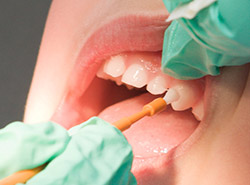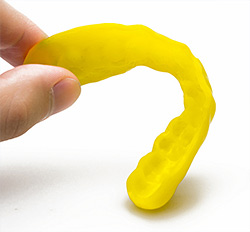Common Dental Procedures
Topics on this page

Regular Exams and Cleanings
Regular exams are an important part of maintaining your child's oral health. During your child’s regular exam, we will:
- Check for any problems that may not be seen or felt
- Look for cavities or any other signs of tooth decay
- Inspect the teeth and gums for gingivitis and signs of periodontal disease
- Perform a thorough teeth cleaning
- Check for an early orthodontic problems such as crowding or bite issues
Your child’s exam will take about 30 minutes. Each regular exam includes a detailed teeth cleaning, in which we will clean, polish, and rinse the teeth to remove any tartar and plaque that have built up on the tooth’s surface.
Visiting our office every six months gives you the chance to talk to the doctor about any questions you may have about your child’s oral health. Regular exams are offered by appointment only, so please contact our practice today to schedule your child’s next dental exam and teeth cleaning.
Crowns
Crowns are a restorative procedure used to improve a tooth’s shape or to strengthen a tooth. Crowns are most often used for teeth that are broken, worn, or have portions destroyed by tooth decay. Crowns are needed when there is insufficient tooth strength remaining to hold a filling.
A crown is a “cap” cemented onto an existing tooth that usually covers the portion of the tooth above the gum line. In effect, the crown becomes the tooth’s new outer surface.
Extractions
 There are times when it is necessary to remove a tooth. Sometimes a tooth has a cavity so large that the tooth is irrepairable. Other times a tooth may develop an infection from decay, trauma, or restorative history that requires an extraction. Additionally, teeth may need to be removed if there are issues with proper permanent tooth eruption or if severe crowding is present.
There are times when it is necessary to remove a tooth. Sometimes a tooth has a cavity so large that the tooth is irrepairable. Other times a tooth may develop an infection from decay, trauma, or restorative history that requires an extraction. Additionally, teeth may need to be removed if there are issues with proper permanent tooth eruption or if severe crowding is present.
When it is determined that a tooth needs to be removed, your child’s dentist may extract the tooth during a regular checkup or may request another visit for this procedure. If an extraction is required, your doctor will discuss the procedure with you in more detail.
Fillings
 When a cavity occurs in a tooth, the weakened portion of the tooth is removed and then repaired with a filling material. Our office utilizes composite dental fillings to repair these areas. Composite fillings contain compounds that mimic the appearance of natural teeth. These compounds, often called composite resins, are typically used on the front teeth where a natural appearance is important, as well as smaller areas of decay on posterior (back) teeth.
When a cavity occurs in a tooth, the weakened portion of the tooth is removed and then repaired with a filling material. Our office utilizes composite dental fillings to repair these areas. Composite fillings contain compounds that mimic the appearance of natural teeth. These compounds, often called composite resins, are typically used on the front teeth where a natural appearance is important, as well as smaller areas of decay on posterior (back) teeth.
Fluoride
 Fluoride is effective in preventing cavities and tooth decay and can be found in toothpaste, drinking water, as well as naturally occuring in many foods and drinks we consume. A professional fluoride treatment in the dental office is also routinely recommended every 6 months to help strengthen teeth and fight against future cavity development. A fluoride application takes just a few minutes. Depending on your child’s oral health or the doctor’s recommendation, a fluoride treatment may be required more frequently.
Fluoride is effective in preventing cavities and tooth decay and can be found in toothpaste, drinking water, as well as naturally occuring in many foods and drinks we consume. A professional fluoride treatment in the dental office is also routinely recommended every 6 months to help strengthen teeth and fight against future cavity development. A fluoride application takes just a few minutes. Depending on your child’s oral health or the doctor’s recommendation, a fluoride treatment may be required more frequently.
Mouthguards
 Whether your child wears braces or not, protecting his or her smile while playing sports is essential. Mouthguards help protect the teeth and gums from injury. If your child participates in any kind of full-contact sport, the American Dental Association recommends that he or she wear a mouthguard. Choosing the right mouthguard is essential. There are three basic types of mouthguards: the pre-made mouthguard, the “boil-and-bite” fitted mouthguard, and a custom-made mouthguard from the dentist. When you choose a mouthguard, be sure to pick one that is tear-resistant, comfortable and well-fitted for your mouth, easy to keep clean, and does not prevent your child from breathing properly. Your dentist can show your child how to wear a mouthguard properly and how to choose the right mouthguard to protect his or her smile.
Whether your child wears braces or not, protecting his or her smile while playing sports is essential. Mouthguards help protect the teeth and gums from injury. If your child participates in any kind of full-contact sport, the American Dental Association recommends that he or she wear a mouthguard. Choosing the right mouthguard is essential. There are three basic types of mouthguards: the pre-made mouthguard, the “boil-and-bite” fitted mouthguard, and a custom-made mouthguard from the dentist. When you choose a mouthguard, be sure to pick one that is tear-resistant, comfortable and well-fitted for your mouth, easy to keep clean, and does not prevent your child from breathing properly. Your dentist can show your child how to wear a mouthguard properly and how to choose the right mouthguard to protect his or her smile.
Sealants
 Sometimes brushing is not enough, especially when it comes to those hard-to-reach spots in your child’s mouth. It is difficult for a toothbrush to get in between the small cracks and grooves on your child’s teeth. If left alone, those tiny areas can develop tooth decay. Sealants give your child’s teeth extra protection against decay and help prevent cavities.
Sometimes brushing is not enough, especially when it comes to those hard-to-reach spots in your child’s mouth. It is difficult for a toothbrush to get in between the small cracks and grooves on your child’s teeth. If left alone, those tiny areas can develop tooth decay. Sealants give your child’s teeth extra protection against decay and help prevent cavities.
Dental sealants are a plastic resin that bonds and hardens in the deep grooves on your child’s tooth’s surface. When a tooth is sealed, the tiny grooves become smooth and are less likely to harbor plaque. With sealants, brushing your child's teeth becomes easier and more effective against tooth decay.
Sealants are typically applied to children’s teeth as a preventive measure against tooth decay after the permanent teeth have erupted. It is more common to seal “permanent” teeth rather than “baby” teeth, but every patient has unique needs, and your child’s dentist will recommend sealants on a case-by-case basis.
Sealants last from three to five years, but it is fairly common to see adults with sealants still intact from their childhood. A dental sealant only provides protection when it is fully intact, so if your child’s sealants come off partially or fully, it may need to be repaired or replaced.



